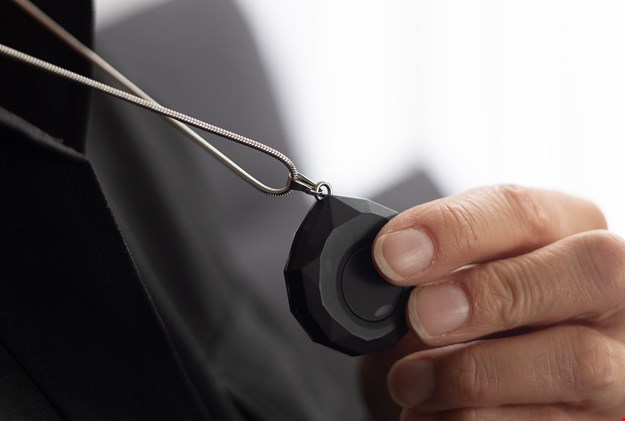-
Country
-
Search
Country

Search
A pendant alarm connected to a social alarm can help to make everyday life safer for the elderly and vulnerable people. Technology enabled care can take many different forms, and when Careium developed the Ellis pendant alarm, the focus was on needs-based design. The result is an alarm that is not only aesthetically pleasing, it also fulfils the very important function of being a reassurance for the user.
Style and design are a way in which we can express ourselves, and it doesn't become less important just because we get older. A pendant alarm is something a service user should wear every day, so who says it can't be elegant and stylish? Robert Horney, Hardware Developer and Peter Cullin, Category Manager at Careium, joined forces to develop a pendant alarm, designed in a completely new way, with a focus on the user. The result was Ellis – a pendant alarm you should feel comfortable wearing and that does not feel like an aid, but rather like a beautiful piece of jewellery.
Needs-based design means focusing on creating solutions for a specific target group and taking the individual's needs into account. It is also important to include the users in the design process, to take their views on board and design the product according to their unique circumstances. The ultimate goal is to create a user-based solution that ignores preconceptions, to create a product that is both functional and encourages use.

Peter Cullin explains that a common problem with today’s pendant alarms are that users prefer not to wear them as it can feel stigmatising.
“Everyone thinks of the design, regardless of age. As a young person, it’s easy to have the preconception that just because you get older, it stops being important. We don't want people to turn a social alarm down because too little emphasis has been placed on the aesthetic part of the design. The fact that this can lead to people choosing not to wear their alarm is a problem. With Ellis, we have tried to create an alarm where function and aesthetics go hand in hand with the ultimate goal that users should feel proud when wearing the alarm.”
Designed as a piece of jewellery, Ellis is worn around the neck on a chain, so it looks more like a necklace than a traditional alarm. The chain has a magnetic link, which makes it safe to sleep with as it becomes detached if it gets caught on something. The button itself is located on the back, the service user can trigger the alarm simply by pressing it, if something were to happen. Putting the button on the back was a very deliberate choice, says Robert Horney.

“Behind the final design lies solid work where we tested different models and it was a very fun and creative design process. Placing the alarm button on the back was a deliberate choice. The alarm button is usually placed facing outwards. We chose to turn it around, because it feels natural to use your thumb to trigger the alarm and because it hides the button, so it looks like a piece of jewellery and not a classic alarm. The user can choose which side of the alarm they like the best and therefore want to display – the glossier front or the matt back with the alarm button.”
Before the pendant alarm was launched, it was tested by service users in Lund municipality, Sweden, with positive reviews as a result. Users found that Ellis was comfortable to wear and that the alarm was also easier and more natural to press when using their thumb. At the end of the test period, everyone who got to use the alarm stated that they wanted to keep Ellis and continue using it in the future, which can be seen as good feedback.

